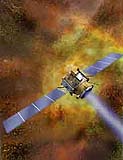| . |  |
. |
 Salvaging Deep Space One
Salvaging Deep Space Oneby Bruce Moomaw Cameron Park - February 7, 2000 - After the failure of Deep Space 1's star tracker, it looked as though the spacecraft's career in deep space might be over -- but JPL was not willing to give up so easily. The ground controllers developed a plan to reprogram the craft so that it could use its MICAS CCD camera as a substitute star tracker. Despite the problems in the quality of its pictures, they are more than adequate for that purpose. In order to transmit the new software, though, they first had to repoint the craft's high-gain antenna at Earth, since at the time it was limited to a very low-speed communications relay through its ominidirectional antennas. During January, they commanded the probe to slowly slew around until the strength of the radio beam from its high-gain dish was at a maximum -- and then to use its motion rate-sensing gyros to keep it pointed in that direction with periodic attitude-readjustment commands from Earth to compensate for natural gyro drift. This technique has allowed the DS1 team to reestablish regular high-speed communications sessions with the craft, and begin transmitting the new software as it is developed -- which will in turn allow DS1 to resume thrusting with its ion engine and head for its next target. There are, however, two problems with this new technique. First, while the CCD camera is being used as a star tracker, it's difficult to use it to photograph star fields to provide DS1's AutoNav system with information from which it can calculate the probe's position -- so from now on, DS1 will have to be tracked using old-fashioned ground-based radio tracking. This, however, will be quite adequate to achieve its goals -- and the feeling is that the AutoNav system was given an adequate test of its navigational abilities during the first part of the probe's mission. Second, the new software cannot be fully loaded until May, so DS1 will not be able to resume thrusting with its ion drive until then -- too late for it to veer itself onto a path that would allow it to fly past both the targets it had hoped to reach in 2001. One or the other had to be chosen -- and, scientifically, they are very different. The first is Wilson-Harrington, a strange little object -- about 3 km across -- which seems to be a comet nucleus that was discovered just at the moment it was finishing "drying out", expelling the very last of the ice it originally contained when the Sun's heat boiled it into gas during its perihelion passages. It was first sighted in 1949 as a comet with no coma, but a faint tail -- but then it disappeared. In 1979, a near-Earth asteroid was sighted which turned out to be in exactly the same orbit as the "comet" of 1949, but it has shown absolutely no sign of activity since. Some scientists though, think it may be a perfectly ordinary small asteroid which had just been struck by a meteoroid when it was sighted in 1949, and was being trailed by a cloud of debris. Deep Space 1 could make a very close flyby of it in March 2001. The other target, Borrelly, is about as different as possible -- it is one of the brightest and most active of the current "short-period" with periods of only a few years. Since comets are preserved remnants of the primordial cloud of material out of which the Solar System condensed, astronomers are extremely eager to study their chemical composition -- and since this can be done most easily by analyzing the cloud of gases and dust that make up their "coma" when they approach the Sun closely, Borrelly was the clear favorite target from the start. Over the weekend of Jan. 21-22, the DS1 science team officially decided that a flyby of Borrelly in September 2001 will be DS1's new goal. Thus, with luck, DS1 will provide us with only our second closeup visual look at a comet nucleus, after "Giotto's" visit to Halley in 1986 -- and its pictures may be much sharper. Deep Space One Special Report Onward To Comet Borrelly
|
| |||||||||
| The content herein, unless otherwise known to be public domain, are Copyright 1995-2016 - Space Media Network. All websites are published in Australia and are solely subject to Australian law and governed by Fair Use principals for news reporting and research purposes. AFP, UPI and IANS news wire stories are copyright Agence France-Presse, United Press International and Indo-Asia News Service. ESA news reports are copyright European Space Agency. All NASA sourced material is public domain. Additional copyrights may apply in whole or part to other bona fide parties. Advertising does not imply endorsement, agreement or approval of any opinions, statements or information provided by Space Media Network on any Web page published or hosted by Space Media Network. Privacy Statement All images and articles appearing on Space Media Network have been edited or digitally altered in some way. Any requests to remove copyright material will be acted upon in a timely and appropriate manner. Any attempt to extort money from Space Media Network will be ignored and reported to Australian Law Enforcement Agencies as a potential case of financial fraud involving the use of a telephonic carriage device or postal service. |